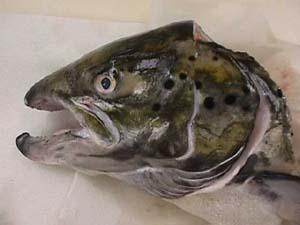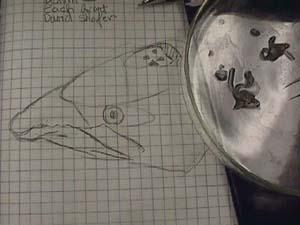3 August, 1999
Aloha from UH (The University of Hawaii--Manoa), It has been a quiet, yet
busy day. I spent the latter part of the morning looking for a salmon fish
head. I went first to my local grocery store. They had heads for only $.25
that were almost as large as my own; they were ahi, which is Hawaiian for
yellow fin tuna. Finally I found a salmon head that was reasonable is size.
This time I took photos and drew pictures to help me memorize the location
of the otoliths. Happily I found all three this time, but because the head
had been frozen; the smaller structures had recrystallized into another
form of calcium carbonate distorting the shape somewhat. Aragonite is one
form and Calcite is the second.
I then spent part of my day reading some journals that Dr. Radke had
written on some of the research he has already done on charr. I believe I
mentioned that rings grow on the otoliths, much like the rings of tree. It
is believed that these rings are deposited daily. The experiment they
performed was to rear charr for a set time period under different
temperature and feeding regimes to see if the incrementation of the rings
occurred daily. They found that at 7 degrees Centigrade and daily feeding
this was true, but if the temperature was lowered to 1 or 3 degrees
Centigrade or the food supply was limited the incrementation would
fluctuate.
I asked Dr. Radke about the spawning habits of the charr. He said they are
different from salmon in that they do not necessarily go to saltwater as
juveniles and they do not return to the freshwater to die after spawning.
Some fish remain in the freshwater and some may or may not migrate on a
year to year basis to the saltwater for the better food supply in the
summer months. If they do migrate, they will return to freshwater when the
temperature drops to 0 centigrade because unlike most arctic fish they do
not have antifreeze in their blood. They will winter over in lakes where
the water will not freeze to the bottom. The final part of my day I spent
preparing two glass microscope slides with a small slice of cardboard
sandwiched between them. Holding it firmly together is a metal frame. The
cardboard will have holes punched out which will contain the otoliths that
we collect.

Salmon fish head. This is the part of the fish we will be taking from the field back to the lab on the Thule air base for dissection.

Drawing of head showing otolith cavity at top upper right. At the top of the petrie dish are the small white otoliths and the surrounding tissue are below.

Contact the TEA in the field at
.
If you cannot connect through your browser, copy the
TEA's e-mail address in the "To:" line of
your favorite e-mail package.
|
